Brick & Bolt: The Role of AI in Enhancing Construction Safety

In the construction industry, ensuring site safety is essential for both workers and project success. Artificial intelligence (AI) is revolutionising how construction companies such as Brick & Bolt approach safety by providing innovative tools to monitor, predict, and prevent potential hazards. Through AI-driven insights and technology, the industry is now better equipped to maintain safer work environments. This blog explores how AI is enhancing construction safety, from real-time hazard detection to advanced safety planning, shaping a safer future for construction.
1. Real-Time Hazard Detection
AI-powered cameras and sensors are now capable of detecting potential hazards on construction sites in real-time. By monitoring areas prone to accidents, these technologies can alert workers to avoid unsafe zones or adjust their practices. For example, computer vision algorithms can identify when workers aren’t wearing protective gear or when they’re in proximity to dangerous machinery. This immediate feedback loop enables proactive responses, reducing the likelihood of injuries.
2. Predictive Maintenance of Equipment
AI has made significant advancements in predictive maintenance, helping prevent equipment-related accidents. By analysing data from machines, AI can forecast when specific equipment parts are likely to fail, allowing for timely repairs and replacements. This is particularly beneficial for heavy machinery often used in construction. With predictive maintenance, Brick & Bolt can ensure that machinery is consistently safe to use, reducing unexpected breakdowns that could pose risks to on-site workers.
3. Enhanced Risk Assessment and Planning
AI assists project managers by identifying potential risks at the project planning stage. Using data from past projects, AI algorithms can predict risk factors based on weather, location, site layout, and worker schedules. These insights allow for more accurate planning, helping teams take preventive measures that make the job site safer and more efficient. For instance, if a project’s location has a history of high winds, AI can flag this and suggest scheduling adjustments to limit work at elevated heights on those days.
4. Worker Health Monitoring
AI-driven wearable devices are increasingly popular in construction for monitoring worker health. These devices can track vital signs, such as heart rate and body temperature, to detect signs of fatigue or heat stress, alerting both the worker and supervisors when breaks or adjustments are needed. By promoting worker health, AI reduces accidents related to physical exhaustion or ill-health making construction sites safer overall.
5. Safety Training and Simulation
AI-based simulations allow construction workers to practise safety protocols in virtual environments before stepping onto the site. These simulations provide realistic, hands-on training for handling machinery, understanding site layouts, and responding to potential hazards. Enhanced training translates to safer behaviour on the actual job site, as workers are better prepared to handle challenges that may arise.
6. Improving Emergency Responses
AI can enhance emergency response measures on construction sites by offering real-time incident analysis and automated alerts. In the event of an emergency, AI systems can direct workers to safe exit routes, minimising response times and potential harm. Additionally, AI can log and analyse incidents, providing valuable data that companies like Brick & Bolt can use to improve future emergency protocols.
7. Automated Safety Inspections
Conducting safety inspections is time-intensive, but AI-enabled drones and robots now help companies complete inspections faster and with higher accuracy. AI-powered inspections can detect structural weaknesses or environmental hazards on a site without needing humans to access potentially dangerous areas. Automated inspections are not only quicker but also reduce the risk of human error, offering more thorough and precise evaluations.
8. Data-Driven Safety Insights
AI can analyse vast amounts of safety data, including records from past projects, to identify patterns that may indicate potential risks. By examining variables like site layout, machinery used, and worker activity, AI can uncover common safety issues and provide actionable insights to reduce them. These insights help construction companies implement targeted safety improvements and anticipate challenges on future projects, fostering a culture of continuous safety enhancement.
9. Enhanced Site Surveillance and Security
AI-powered drones and surveillance systems can patrol construction sites autonomously, identifying unauthorised access and monitoring compliance with safety protocols. These systems can automatically alert site managers to breaches or hazardous conditions, such as exposed edges or unsecured equipment. Improved surveillance not only deters unauthorised entry but also keeps workers informed about changing conditions, enhancing overall site safety.
Conclusion
AI is reshaping construction safety by enhancing every aspect, from real-time monitoring to predictive insights and advanced worker training. For companies like Brick & Bolt, integrating AI into safety practices represents a commitment to a safer, more reliable construction process. With AI’s continued advancements, the construction industry can look forward to even higher standards of safety, protecting both workers and project integrity alike.


Comments
Post a Comment